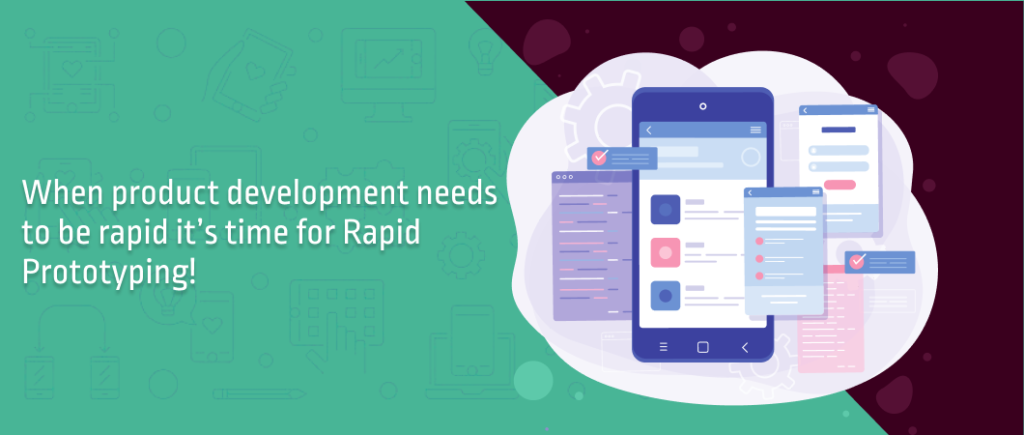Last updated on October 21st, 2024
The popular adage, “a picture speaks a thousand words” applies perfectly to product prototypes. In times when over 30,000 products are released each year, how do product companies achieve the necessary “speed” in their product development and release cycles? Through rapid prototyping in software development.
Be it for a website or application, software rapid prototyping is the process of quickly “mocking” a prototype of its future state using loads of simulations and visuals. Rapid prototyping in software engineering can be achieved easily even using some rough product sketches on paper to design interactive simulations that behave almost like the final product.
The “traditional” waterfall model of software development invested too much time into product designing. On the other hand, the rapid prototyping model in software engineering is designed for the Agile development environment and allows product designers to move quickly without spending time on detailed product prototyping.
What is rapid prototyping and how can it satisfy the need for speed in product development? Let’s explore.
What is Rapid Prototyping?
Traditional prototyping was always a part of the manufacturing process with companies using Computer-aided design or CAD prototyping to create proof-of-concept models. However, this approach always ran into bottlenecks or inefficiencies.
Rapid prototyping can be used to create prototypes directly from the design data and make frequent iterations in the product design based on user feedback and reviews. Rapid application prototyping involves many design iterations in the following three-step process namely:
- Prototyping or the first step in converting the plausible solution into a product mock-up.
- Reviewing or the process of sharing the initial prototype with users and reviewing if it satisfies their needs or expectations.
- Refining or the step where the product prototype design is identified for further refining based on the user’s feedback.
Effectively, rapid prototyping can be deployed at any stage of the product development for any of its components and can be repeated to achieve the optimum product design.
Next, let us look at some of the advantages of rapid prototyping in product development.
Advantages of Rapid Prototyping in product development
How does rapid prototyping help in software product development? Here are a few of its advantages:
- Cost reduction
The use of rapid prototyping in product development can help in converting product “ideas” into a “subject” quickly and efficiently. Rapid prototyping tools can save both development time and cost by helping product teams develop the final product faster.
Additionally, product development companies can also reduce costs “down the road” in any Agile development environment with its iterative processes. By incorporating feedback from users, product companies can reduce the cost wasted in developing an unoptimized or inefficient product, along with the costs of releasing it to the market.
- Functionality testing
Product prototypes that emerge from rapid prototyping techniques are designed to represent the final application. This enables efficient functionality testing, where design flaws can be identified and rectified before the actual development phase. Further, product prototypes can expand the scope for “new” features or enhancements, along with areas that would need more work.
An example of this is the use of functional prototypes that is built as an accurate representation of the user experience. Simulated integrations can represent and demonstrate real-life scenarios with real-time data feeds.
- Improved product features and releases
On its part, rapid prototyping enables product development teams to identify the features that need to be prioritized for meeting user needs. Rapid prototyping removes the “guesswork” from the product planning activities, as there is no need to spend hours “brainstorming” about what customers are looking for.
Rapid prototyping works efficiently as it is based on user feedback about the product and what they are looking for in your actual application. This enables faster product releases, which is key to gaining a competitive advantage in the software market.
- Risk management
Studies reveal that the failure rate for software products or application range between 50 and 80%. Product failures in the market can cause enormous financial losses to product companies. Effectively, companies can reduce the risk of a product failure through proper prototyping before the development phase. Design or functionality-related problems can be fixed in the prototyping phase instead of after releasing the product in the market.
Similarly, rapid prototyping can reduce design failures in the development stage, thus reducing the risk of escalating project costs or failures.
- Stakeholder involvement
In addition to the product development team, rapid prototyping encourages the involvement of multiple stakeholders including customers, maintenance teams, and the executive team. They can effectively provide constructive feedback about the product’s usability and design and collaborate on improving application features based on market needs and competitive products.
The rapid prototyping model makes it easier to implement design changes using its iterative process, thus ensuring continuous improvement.
Next, let us look at a few examples of rapid prototyping in product development.
What are rapid prototyping examples?
Among the frequently used examples of rapid prototyping, three-dimensional printing (or 3D printing) can save both time and costs in developing product models. In reality, rapid prototyping is much more than 3D printing and can be developed using many tools like CAD drawings, application mock-ups, storyboards, and even paper sketches.
Besides paper-based prototyping, product designers can avail of rapid prototyping tools like Easel, Invision, and Flinto to create prototypes without any application coding. Other recommended prototyping tools include Moleskin, Web Design Sketchbook, and the “Print on your own” tool for sketching product-related “ideas” while on the move.
Mockplus is another example of a rapid prototyping tool that can be used to design applications for desktop computers, mobile phones, and tablets. With its user-friendly interface, Mockplus is favored by many product designers and developers.
Conclusion
In summary, rapid prototyping can help product companies achieve speed and reduce costs in their product development process. Be it any product or service, rapid prototyping can help in analyzing any application’s strengths and weaknesses in the initial development phase.
At Forgeahead, we specialize in converting great “ideas” into innovative products. With over 20 years of industry experience, we offer technology-related services in the areas of SaaS product development, DevOps, Serverless computing, and more.
Do you want an “interesting idea” to tap into as a business? We can help. Contact us today.



